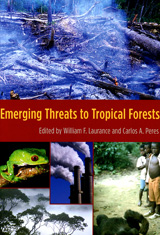3 books about Laurance, William F.

Emerging Threats to Tropical Forests
Edited by William F. Laurance and Carlos A. Peres
University of Chicago Press, 2006
Emerging Threats to Tropical Forests reveals the remarkably diverse panoply of perils to tropical forests and their biota, with particular emphasis on recent dangers. William F. Laurance and Carlos A. Peres identify four categories of emerging threats: those that have only recently appeared, such as the virulent chytrid fungus that is decimating rainforest amphibians throughout the tropical world; those that are growing rapidly in importance, like destructive surface fires; those that are poorly understood, namely global warming and other climatic and atmospheric changes; and environmental synergisms, whereby two or more simultaneous threats—such as habitat fragmentation and wildfires, or logging and hunting—can dramatically increase local extinction of tropical species. In addition to documenting the vulnerability of tropical rainforests, the volume focuses on strategies for mitigating and combating emerging threats. A timely and compelling book intended for researchers, students, and conservation practitioners, Emerging Threats to Tropical Forests will interest anyone concerned about the fate of the world’s most threatened tropical ecosystems.
[more]

Stinging Trees and Wait-a-Whiles
Confessions of a Rainforest Biologist
William Laurance
University of Chicago Press, 2000
The last traces of Australia's tropical rainforest, where the southeasterly winds bring rain to the coastal mountains, contain a unique assemblage of plants and animals, some primitive, many that are found nowhere else on earth. And fifteen years ago, they also contained Bill Laurance, a budding ecologist seduced by the nature of the landscape in north Queensland. Laurance isn't your typical scientist: he wears cut-offs instead of white coats, enjoys the occasional food fight, and isn't afraid to speak his mind, even if it gets him into trouble, as it often did in the Australian rainforest and as he recounts in his marvelous Queensland journal Stinging Trees and Wait-a-Whiles.
The book is his record of the time he spent in this remote area and his run-ins with plant, animal, and human species alike. Laurance lived in a tiny town of loggers and farmers, and he witnessed firsthand the impact of conservation issues on individual lives. He found himself at the center of a bitter battle over conservation strategies and became not only the subject of small-town gossip but also the object of many residents' hatred. Keeping ahead of his high-spirited young volunteers, hounded by the drug-sniffing local policeman, and all the while trying to further his own research amid natural and unnatural obstacles, Laurance offers us a personal and hilarious account of fieldwork and life in the Australian outpost of Millaa Millaa. Stinging Trees and Wait-a-Whiles is a biology lesson, a conservation primer, and an utterly energetic story about an impressionable young man who wound up at the epicenter of an issue that tore a small town apart.
The book is his record of the time he spent in this remote area and his run-ins with plant, animal, and human species alike. Laurance lived in a tiny town of loggers and farmers, and he witnessed firsthand the impact of conservation issues on individual lives. He found himself at the center of a bitter battle over conservation strategies and became not only the subject of small-town gossip but also the object of many residents' hatred. Keeping ahead of his high-spirited young volunteers, hounded by the drug-sniffing local policeman, and all the while trying to further his own research amid natural and unnatural obstacles, Laurance offers us a personal and hilarious account of fieldwork and life in the Australian outpost of Millaa Millaa. Stinging Trees and Wait-a-Whiles is a biology lesson, a conservation primer, and an utterly energetic story about an impressionable young man who wound up at the epicenter of an issue that tore a small town apart.
[more]

Tropical Forest Remnants
Ecology, Management, and Conservation of Fragmented Communities
Edited by William F. Laurance and Richard O. Bierregaard Jr.
University of Chicago Press, 1997
We live in an increasingly fragmented world, with islands of natural habitat cast adrift in a sea of cleared, burned, logged, polluted, and otherwise altered lands. Nowhere are fragmentation and its devastating effects more evident than in the tropical forests. By the year 2000, more than half of these forests will have been cut, causing increased soil erosion, watershed destabilization, climate degradation, and extinction of as many as 600,000 species.
Tropical Forest Remnants provides the best information available to help us
understand, manage, and conserve the remaining fragments. Covering geographic areas from Southeast Asia and Australia to Madagascar and the New World, this volume summarizes what is known about the ecology, management, restoration, socioeconomics, and conservation of fragmented forests. Thirty-three papers present results of recent research as
well as updates from decades-long projects in progress. Two final chapters synthesize the state of research on tropical forest fragmentation and identify key priorities for future work.
Tropical Forest Remnants provides the best information available to help us
understand, manage, and conserve the remaining fragments. Covering geographic areas from Southeast Asia and Australia to Madagascar and the New World, this volume summarizes what is known about the ecology, management, restoration, socioeconomics, and conservation of fragmented forests. Thirty-three papers present results of recent research as
well as updates from decades-long projects in progress. Two final chapters synthesize the state of research on tropical forest fragmentation and identify key priorities for future work.
[more]
READERS
Browse our collection.
PUBLISHERS
See BiblioVault's publisher services.
STUDENT SERVICES
Files for college accessibility offices.
UChicago Accessibility Resources
home | accessibility | search | about | contact us
BiblioVault ® 2001 - 2024
The University of Chicago Press









